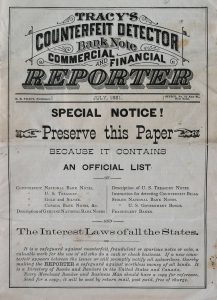May 1, 2020 | gold, investment, markets
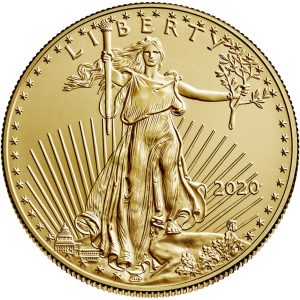 In last Sunday’s Weekly World Numismatic News, it opened with a discussion about how gold and silver were doing in the current market. While researching the data, the indication was that physical bullion and electronic purchases were driving the markets. Bullion coins were not a factor.
In last Sunday’s Weekly World Numismatic News, it opened with a discussion about how gold and silver were doing in the current market. While researching the data, the indication was that physical bullion and electronic purchases were driving the markets. Bullion coins were not a factor.
On Monday, Bloomberg News published an article that suggested otherwise. The article notes that retail buyers of gold are paying up to $135 per ounce above spot prices. An analyst interview for the article said, “There has never been a time for American Gold Eagles at this premium level.”
A call to a trusted source explained the differences in the reporting.
Last year, gold hit a low of $1,269 per troy ounce. With good economic indicators, investors thought that the prices would continue to fall. The market did not see value in buying a declining asset. Sellers were hoarding their stock until prices became more favorable.
The lack of buying, especially by retail investors, left dealers with a lot of inventory. With inventory building, dealers did not buy additional coins from the U.S. Mint’s dealers. As the prices rose, sellers started to sell their gold coins adding to the inventory.
Then came the coronavirus pandemic.
Markets hate uncertainty. The coronavirus pandemic has made uncertainty the only certainty. Not knowing where to turn, many sources are reporting significant gold sales. Where the reports differ is the source of the gold.
Although sources confirm that physical bullion and warrants are producing the highest volumes, they say it is because the investors cannot find enough bullion coins to satisfy market demands. The markets adjusted.
The demand increased when the U.S. Mint temporarily closed the West Point Mint. While the reaction did not rise to panic-like levels, retail gold buyers sought bullion coins, primarily American Gold Eagles, with greater urgency.
Professional investors are buying bullion and other gold products, including classic United States gold coins. The retail demand for American Gold Eagle coins has driven up the price. As the price for Eagles rises, it has driven up the cost of other bullion coins, including the Canadian Maple Leaf and Krugerrand.
When considering the purchase of gold coins, keep the spread in mind. If you purchase gold coins with a $150 premium over spot, to ensure that your investment generates a return, the bid price has to raise $150 plus whatever premiums dealers place on the coins. It might require the price of gold to rise $200-255 per troy ounce to break even.
Investors thought that the supply would ease with the Royal Canadian Mint resuming processing of bullion. However, in the beginning, the Royal Canadian Mint will produce large gold bars to satisfy orders from central banks so they can settle on accounts. They will also be striking silver Maple Leaf bullion coins.
Some reports suggest that most of the early production of silver coins will stay in Canada.
After discussing the markets with three different analysts, the only certainty is uncertainty. Each had an opinion that differed from each other but agreed that someone is going to make money.
Apr 27, 2020 | gold, investment, markets, news, silver
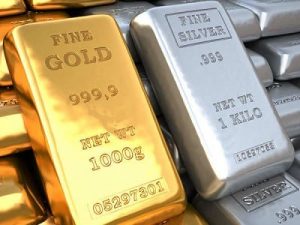 As the stay or safe at home orders continue, news in the investing world around coins and bullion is whether there will be a recovery and what will happen.
As the stay or safe at home orders continue, news in the investing world around coins and bullion is whether there will be a recovery and what will happen.
While investors are turning to gold as the equity markets are less than stable, reports that bullion and bullion-related warrants are outselling all coin offerings. Even though the West Point Mint briefly paused coin production, the markets have not felt the impact.
Silver prices are faring as well as gold. The area that silver is gaining strength is in the industrial markets. Driving the price is the demand for electronics. The primary use of silver is in the braising that ensures the connections between the chips are secure and with the production of LEDs.
Industrial silver is in more demand than industrial gold. As Asian electronics production begins to ramp up, some investors feel that there may be a temporary shortage of silver. One analyst suggested that silver prices could climb to $18 per ounce. Silver is currently $15.26 per troy ounce.
On the other hand, the reports of economic contraction have suggested that bullion prices will collapse. If this is the case, then there will be more to worry about than the market price of bullion.
And now the news…

April 22, 2020
People have been collecting coins for about as long as coins have been made. That’s a passion that has endured for centuries, since roughly 600 to 800 BC. Coin collecting is a worthwhile hobby and can sometimes be a financially savvy investment.

→ Read more at
washtimesherald.com

April 23, 2020
Gold coin demand makes up a small part of total demand, and thus doesn’t have much impact on the gold price. Demand for gold coins must be seen as a retail sentiment indicator.

→ Read more at
seekingalpha.com

April 25, 2020
Copper is well documented for its impressive antibacterial properties. Even Ancient Egyptians used bronze filings (an alloy of copper and tin) from their freshly sharpened swords to treat their wounds.

→ Read more at
iflscience.com

April 25, 2020
What's True The reverse of a U.S. quarter issued in 2020 honoring the National Park of American Samoa features a pair of fruit bats.

→ Read more at
snopes.com
Apr 5, 2020 | bullion, gold, markets, news, silver
I know it is difficult to turn away from the news. It is like watching an automobile accident in slow motion. Every day it seems like there is something else. Unfortunately, this is true about the precious metals market.
Europe, which appears to be taking the closings and stay-at-home orders better than the United States, is trying to figure out what will happen to the economy after everything reopens. That is wreaking havoc with the market.
In one story, Germany is beginning to buy gold in preparation for future spending while institutions in Italy are selling gold to stay afloat. While African mines continue to bring metals to the market, investors are buying gold as a hedge for an uncertain future.
In the last 30-days, the price of gold has bounced back almost to pre-market shaking announcements about COVID-19 in the United States. Other metals have not been as active. According to a source, the only thing keeping the price of silver somewhat stable is its industrial use.
Coins and other collectibles that are sensitive to the precious metals market will begin to see a disparity in prices. Common gold coins whose price is tied to the metals market will rise. Silver coins will likely not move on the metals market.
During a conversation with a professional metals trader, I asked what is next for the market. A person who usually has an answer said that he did not know. He said that most traders are not trying to predict the market but react to whatever happens. One of the problems is that the computer models are wrong. In many cases, firms have halted automated metals trading. He said that the situation is so fluid that some of the computer models were buying from themselves.
If you watch the business news on cable television, you will hear a different opinion from every guest. I plan to use the advice given to me: prepare for the worst and turn off the television.
And now the news…

April 1, 2020
On that day, men shall fling away, To the flying foxes and the bats, The idols of silver And the idols of gold Which they made for worshiping. Isaiah 2:20

→ Read more at
breakingisraelnews.com

April 2, 2020
When people are worried about the future they turn to gold to protect their savings. That’s rarely been more true than today.

→ Read more at
finance.yahoo.com

April 2, 2020
I estimate that the Germans own 9000 tonnes in private gold-nearly as much gold as the French and Italians have combined. The World Gold Council (WGC) states there are roughly 198,000 tonnes of gold above ground, of which 35,000 tonnes is held by central banks.

→ Read more at
seekingalpha.com

April 3, 2020
Polish archaeologists have uncovered a treasure trove of Roman denarii coins. They date from the first and the second century BC, and they probably belonged to a member of a Germanic people who lived in the area at the time.

→ Read more at
ancient-origins.net

April 3, 2020
While removing the floor of the church in Obišovce near Košice, the foundations of the old church were uncovered. After this discovery, the archaeological company Triglav conducted research that took place at the beginning of February 2020, the Regional Monuments Board Košice reported.

→ Read more at
spectator.sme.sk
Jul 29, 2019 | bullion, markets, news, silver
One of the indicators as to how the markets view the economy is the price of precious metals. When there is uncertainty in the markets, investors leave the equity markets and buy precious metals. When that happens, it will have an impact on most pre-1965 coins.
Marketwatch reported that silver hit a 13-month high about the same time Iran captured a Britsh tanker. Since then, the silver market leveled out with few signs of dropping. Silver is not selling for at the same level as seen during the economic crisis in as it approached 2011, there continues to be upward pressure on its price.
-

-
30-day Silver Chart (will not update—Courtesy of Kitco)
-
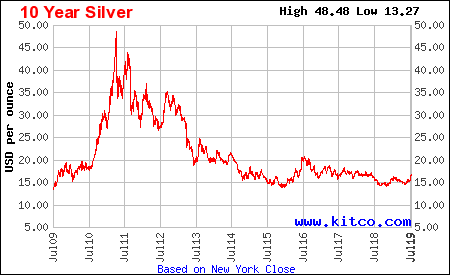
-
10-year Silver Chart (will not update—Courtesy of Kitco)
Silver investing is sometimes called the “poor man’s gold.” When the average investor is uncertain and looks for a safer investment, they will buy silver while the wealthier investors will buy gold. Palladium has emerged as the new investment vehicle for investors with means.
Gold has been more erratic with wild swings in both directions depending on the news of the day. A precious metals fund manager who manages several diverse portfolios called the divergence of the markets curious. There is not a clear explanation for the current rise of silver. If someone were trying to manipulate the market, the prices would climb faster. All she could tell was there were a lot of low-end investors buying into silver.
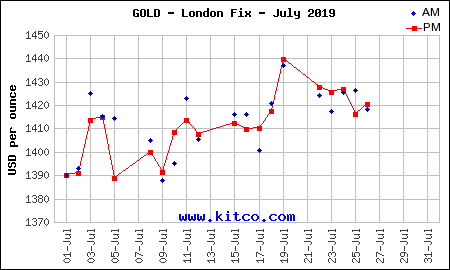
30-day Gold Chart (will not update—Courtesy of Kitco)
For numismatics, the rising price of silver can be problematics. As the price of silver rises, the value of your coins will increase. However, adding to your collection will cost more, especially on those collectible coins whose value is tied to the price of silver.
Those responsible for investing in these markets are beginning to worry. If investors are buying silver as a safe haven, there could be a feeling of a pending economic crisis. Only time will tell if they are right.
And now the news…

July 24, 2019
Present-day tenants of home owned by Jewish family before the Holocaust find jars containing 2,800 coins from as far back as the Roman Empire and as far away as India  → Read more at timesofisrael.com
→ Read more at timesofisrael.com

July 24, 2019
A hoard of Roman coins dating from the time of Queen Boudicca have been found by a metal detectorist in a field. What makes this find especially fascinating is that they may have been hidden there during one of the most interesting periods in Britain’s early history, the revolt against Rome led by the Celtic Queen Boudicca.  → Read more at thevintagenews.com
→ Read more at thevintagenews.com

July 24, 2019
Silver futures settle at a 13-month high on Monday, outpacing strength in gold, which saw prices eke out only a modest gain despite rising tensions between…  → Read more at marketwatch.com
→ Read more at marketwatch.com
Jun 30, 2019 | bullion, economy, gold, investment, markets, news

Price of Gold for the 2nd Quarter of 2019
(Chart courtesy of GoldSeek.com)
With the price of gold opening at $1,279.00 on January 2, 2019, it saw some bumps in its price but has largely averaged a modest gain until the price closed at $1,271.15 on May 21. Then it started to climb and climb rapidly by market standards. On Friday, June 28, the end of the second fiscal quarter, gold closed at $1,409.00. The rise is a 10.8-percent gain since May 21.
Gold is considered a safe bet for investors. It is a way of investing in cash or cash equivalence. Investors buying gold will purchase bullion, gold bullion coins like the American Eagle, or shares in a fund that maintains large stores of gold. There are many types of funds and ways to purchase shares in these funds, but it is not the same as owning the physical gold. Most reports are claiming that investors are interested in purchasing physical gold with bullion coins being the preference.
Investors make money by investing with what they consider a manageable amount of risk. If the risk pays off, they can make a lot of money. The risks that fail must be made up elsewhere. Investors diversify their portfolios to mitigate these risks. However, if the institutional and large investors are moving their monies to safe harbors, like gold, they sense a problem.
This relatively sharp jump in the price of gold is being driven by the major investors who are worried about the future of the U.S. economy. They see the various trade wars being detrimental to the economy. One economist said that the recent hike in soybean tariffs to China is going to have long term effects long after this president leaves office.
Although the United States is no longer an agrarian economy, agriculture plays a significant role in the country’s economic health. Upsetting that role that agriculture plays will cause long-term damage to the economy. The soybean tariffs are believed to be the driver that is scaring investors.
You may ask how are soybeans causing gold to rise?
As part of foreign policy in Africa, the government has been supplying countries with the proper climate the means to grow soybeans. It was a way to make the countries self-sufficient by helping create an economy. In many cases, the United States did not follow through on commitments to help with the infrastructure that is needed to create access to the markets. Countries needed irrigation and road improvements. Rather than helping with the upgrades, the United States government concentrated on the military aspects of these country’s problems. A policy of one-problem-at-a-time.
For at least 15 years, China has ignored the military issues and began to supply the money, supplies, and labor to fix the infrastructure. The Chinese government helped build irrigation systems, roads, and provided transportation to build these economies with the promise that China would buy their products.
Although there was significant Chinese investment in Africa, it was still cheaper to buy soybeans from the United States. That situation changed with the 25-percent tariffs placed on soybean exports. The tariffs raised the price of U.S. soybeans beyond what the Chinese would pay to the African exporters. Now China is importing soybeans from Africa while U.S. farmers are provided allegedly short-term subsidies from the federal government.
Now that the infrastructure is in place for China to import soybeans from Africa, the costs have reduced and is projected to have the long-term effect of lowering the U.S. market for soybeans in China. One economist said privately that even if the tariffs were reduced to pre-trade war levels, it might not make it economically viable for China to buy as much from the United States as it did in the past.
Institutional investors see the loss in revenue from China, the increased deficit in providing welfare to soybean farmers, and the danger of the business not returning to the United States. They also see the reduction of tariffs to Russia for wheat and that Russia is also looking to African and South American countries for wheat sources. The competition is making trade prices drop and is making it look like agriculture trade is in trouble.
If exports of United States agriculture are in trouble, then it will hurt the economy. With the uncertainty added to the risk profile investors and fund managers have to manage, they have turned to gold as the natural, safe harbor.
The rise in gold prices always helps numismatics. It helps boost the prices of gold and, by association, other rare coins. However, if the gold prices go up because of economic stress, it will not matter what happens to numismatic prices. Fewer people will be in the market to buy coins.
And now the news…

June 26, 2019
Gold is a hedge against financial risk, and coins offer convenience.  → Read more at marketwatch.com
→ Read more at marketwatch.com

June 26, 2019
COIN collectors can now get their hands on a Toy Story 4 50p piece – but you can’t use it in shops. The commemorative coin features popular character Woody in colour with the cowboyR…  → Read more at thesun.co.uk
→ Read more at thesun.co.uk
Dec 30, 2018 | coins, markets, news
While considering the news of the past week, the one thing that sticks out is the press release from the Professional Numismatic Guild. The release touts the strength of the high-end, rare coin market with a throwaway line that notes there may trouble for the general collector.
While prices declined during the year for some U.S. coins in easily available lower grades, hundreds of noteworthy coins from early American to modern that are among the finest known of their kind set auction price records….
Prices for collector coins are driven by two principles: the spot price of silver and other metals that were used to strike the coins; the ability for the supply to meet the demand.
Primary spot price that drives the general collector coin market is silver. Silver opened on January 2, 2018, at $17.06 per troy ounce. On Friday, December 28, the price of silver was $15.29. This is a decline of $1.80 for the year or 10.55-percent decrease. This is not something that has occurred in the last month as the stock market had problems. Silver reached its highest price on January 15 when it reached $17.325. The spot price of silver dropped below $17.00 on February 5 and has been on a steady decline all year.
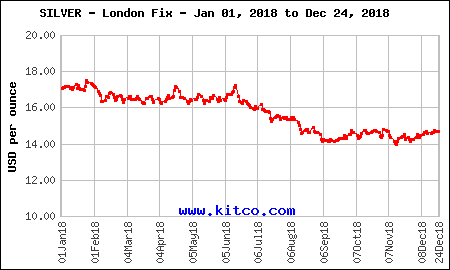
There has been a steady decrease in the spot prices of silver in 2018
(chart courtesy of Kitco; this is a static chart and will not update)
But the price of silver alone is not enough to drive collector coin prices down to get PNG’s attention. The problem is the other part of the equation: supply and demand.
The supply of collector coins is not changing. The coin market is relatively stagnant since the U.S. Mint is no longer making Mercury dimes, Walking Liberty half dollars, or Morgan dollars. There may be an increase in those coins coming to the market as collectors liquidate or the families of deceased collectors liquidate, but is this more than usual?
The number of people collecting may not be enough to drive the market simply because numismatics is not as popular a hobby as it once was.
PNG notes that the success of their high-end business may be coming from investors, not collectors:
“With the stock market dropping during the fourth quarter of 2018 we saw an increase in interest in the rare coin market with some people taking profits from stocks and buying coins that have proven to show sizeable and consistent increases in value over the years, as well as buying precious metals,” said Professional Numismatists Guild President Barry Stuppler.
While it is good that the PNG touts the work of their members in the Top 10% of the market, the general public is not buying. PNG can pat themselves on the back all they want but if they are not helping the entire industry, they are losing the opportunity to turn a general collector into one of their customers.
Further, the American Numismatic Association, which is dominated by the same dealers who are members of the PNG, seem to have a blind spot that prevents them from seeing the general collector as a viable business model to cultivate.
There are only so many times that the industry can claim successes by selling the same 1913 Liberty Head Nickel before everyone, including investors, consider this a market with stale inventory.
This is not to say that the PNG dealers are bad people or have bad intentions. This is saying that the PNG needs to look beyond the top 10-percent of the market to ensure the other 90-percent is just as healthy. Without a market balance and without market diversity, the hobby will be in trouble. Even in the equity markets, low volume low capitalized stocks can cause harm to the market.
And now the news…

December 24, 2018
JEDDAH: The Kingdom’s fiscal trajectory in many ways mirrors the tribulations it endured before emerging as one of the world’s foremost trade and financial hubs. Before the Kingdom was unified by its late founder, King Abdul Aziz, the Arabian Peninsula had suffered its fair share of economic woes thanks to war and political strife within tribal factions.  → Read more at arabnews.com
→ Read more at arabnews.com

December 25, 2018
Coinages issued in Maharashtra dating back to 2600 BCE on display  → Read more at thehindu.com
→ Read more at thehindu.com

December 25, 2018
Gold prices advanced for a second straight day on Tuesday and rose Rs 125 on higher demand from local jewellers  → Read more at livemint.com
→ Read more at livemint.com

December 27, 2018
In a sign of precious metals demand, sales of U.S. Mint American Eagle gold and …  → Read more at reuters.com
→ Read more at reuters.com

December 27, 2018
Earlier this month, my friend Hugo Salinas Price emailed an interesting story about a single gold coin that that he still holds dearly. As I was shuffling papers in some old files, I came across a slip of paper on which I had written down the price I had paid for a Mexican $50 gold peso coin: 717 Mexican pesos.  → Read more at moneymaven.io
→ Read more at moneymaven.io

December 27, 2018
Israel Antiquities Authority, JNF and Border Police stopped a band of thieves from stealing ancient coins from the Hukuk Synagogue archeological site in northern Israel on Thursday. "A quick response prevented damage to the magnificent and important treasures of the site," Nir Distelfeld, the antiquities theft inspector, said.  → Read more at jpost.com
→ Read more at jpost.com

December 28, 2018
Operators of the historic Coin Press No. 1 inside Carson City's Nevada State Museum began striking silver medallions Friday with a commemorative Abraham Curry design created just for the occasion. On the last Friday of each month, the Nevada State Museum runs the coin press, which now mints unique collectible medallions.  → Read more at carsonnow.org
→ Read more at carsonnow.org
Dec 10, 2018 | coins, commentary, markets, silver
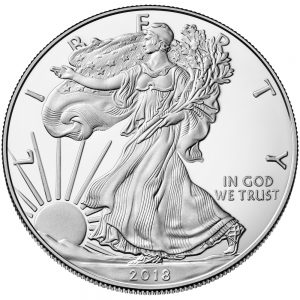 Each week I look at the news from the week in order to highlight something interesting. With the holiday season upon us, I was hoping to find something nice to write about. Instead, Kitco’s story about the increasing sales of silver and a marketplace that is now moving is more concerning than positive.
Each week I look at the news from the week in order to highlight something interesting. With the holiday season upon us, I was hoping to find something nice to write about. Instead, Kitco’s story about the increasing sales of silver and a marketplace that is now moving is more concerning than positive.
Precious metals are the investment of last resort. While some portfolios will diversify into metals for a safe haven, metals become active when there is uncertainty in the market. The trade wars between the United States and China have caused market players to reduce their risk by investing in silver.
Although most prefer gold, silver has been the metal of choice for the Chinese for hundreds of years. It has been the benchmark of their trade and the basis for their monetary system prior to all countries moving off precious metals standards. It was the basis of trade that the United States thought would be resolved by creating the Trade Dollar coin in 1873.
The rise in silver sales from the U.S. Mint is good in that it will increase seigniorage. It is not so good in that it indicates there is the potential for the markets to change course. Markets hate uncertainty and this could be their answer to the uncertainty brewing in trade between China and the United States.
And now the news…

November 28, 2018
Currencies / Fiat Currency The first gold coins appeared around 560 B.C. Over time it became a practice to store larger amounts of gold in warehouses.  → Read more at marketoracle.co.uk
→ Read more at marketoracle.co.uk

November 29, 2018
These days, you can't buy much with 5¢ – including the cost of making one. That's right, the cost of producing a 5¢ piece is about 5.059¢, and this is about the cheapest it's been in recent years. In 2015, the cost of producing a 5¢ piece hit a high of 7¢ due to the fluctuating cost of nickel and copper.  → Read more at smh.com.au
→ Read more at smh.com.au

November 29, 2018
Inmates in a Bulgarian prison were in for a shock when they stumbled across an enormous hoard of silver coins from the Ottoman Empire. The incredible haul was discovered alongside two broken treasure pots in a prison in the Bulgarian city of Pleven.  → Read more at mirror.co.uk
→ Read more at mirror.co.uk

December 2, 2018
The National Bank of Romania (BNR) has put into circulation, for numismatic purposes, a commemorative collector banknote with face value of lei 100 dedicated to the anniversary of 100 years since the Great Union on December 1, 1918.  → Read more at romania-insider.com
→ Read more at romania-insider.com

December 3, 2018
Correcton:The U.S. Mint provided incorrect information on its website Monday morning, misstating the number of ounces sold in December. In an update of its sales data the U.S.  → Read more at kitco.com
→ Read more at kitco.com

December 4, 2018
Rare gold coins and a golden earring have been discovered in the ancient Mediterranean port of Caesarea in northern Israel—possibly left and never recovered as Crusaders conquered the area 900 years ago.  → Read more at phys.org
→ Read more at phys.org

December 6, 2018
It was 150 years ago this month when one of Nevada's most treasured artifacts first arrived in Carson City.  → Read more at carsonnow.org
→ Read more at carsonnow.org

December 6, 2018
Lianna Spurrier has the tooth fairy to thank for a hobby that transformed into sudden job opportunities.  → Read more at thetrailblazeronline.net
→ Read more at thetrailblazeronline.net

December 8, 2018
This article first appeared in the Nevada Appeal on July 20, 2014. Abe Curry received papers on July 16, 1866, approving the start of construction on the Carson Mint.On  → Read more at nevadaappeal.com
→ Read more at nevadaappeal.com
Dec 2, 2018 | bullion, coins, foreign, markets, news, platinum
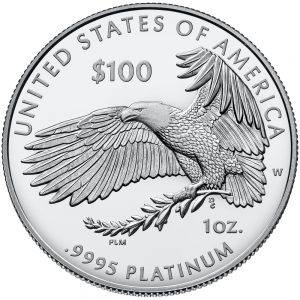 While watching the numismatic news that appears in non-numismatic sources, I noticed that regardless of the predictions of cashless societies taking over, there are a few countries with interest in coins for both commerce and collecting.
While watching the numismatic news that appears in non-numismatic sources, I noticed that regardless of the predictions of cashless societies taking over, there are a few countries with interest in coins for both commerce and collecting.
By far, the one country that seems to have an affinity for coins is India. The news consistently highlights collectors who have coin collections of all sizes and varieties. Whether it is someone who has collected old Indian coins dating back to the Britsh control of the country to someone that collects foreign coins from visitors, there seems to be a story about coin collectors in one of the many Indian news publications.
The other country I can count on for consistent numismatic-related stories is China. Aside from stories about coin shortages and how the poorer areas of the country are hoarding coins, Chinese collectors seem to gravitate toward precious metal coins. Interestingly, Chinese collectors seem to like silver coins even though investors are chasing gold. This is understandable since silver coins can be bigger and cost less.
Recently, it was reported that Chinese collectors are chasing platinum as an investment option. Reports are being circulated that Chinese markets are investing heavily in South African platinum mines allowing the production to increase. With the spot price of platinum ($802.00) lower than the spot prices of gold ($1,222.10) and palladium ($1,170.00), the growth of platinum investment options has grown. The Hang Seng ETF (exchange-traded funds) Index has noted a significant increase in the trading of platinum futures.
Several publications have asked if this means that China is attempting to corner the platinum market. Since I am not a financial analyst, I am not sure. As a numismatist, it is interesting to see that platinum has a growing interest in China.
And now the news…

November 15, 2018
Grab your metal detectors! We are seeking some of the most valuable treasures ever discovered. From buried treasures to sunken treasures, lying beneath villages, towns, cities, farms, riverbeds, and in…  → Read more at invest.usgoldbureau.com
→ Read more at invest.usgoldbureau.com

November 25, 2018
The National Bank of Romania (BNR) has issued several coins to mark the 100-year anniversary of Romania’s 1918 Union. They are a gold coin, a silver coin, and a brass collector coin for numismatic purposes, along with a brass commemorative circulation coin.  → Read more at romania-insider.com
→ Read more at romania-insider.com

November 26, 2018
Limited edition gold and silver coins commemorating the 70th anniversary of the first issuance of the renminbi (RMB) currency and establishment of China's central bank went on sale in China last Friday.  → Read more at gbtimes.com
→ Read more at gbtimes.com

November 26, 2018
The World Platinum Investment Council is pushing for new platinum products to lure Chinese investors into the metal, providing another source of demand for SA’s second-largest mineral export. Weibin Deng, China’s head at the council, which is financially backed by SA’s platinum producers to stimulate investment, outlined plans for coins, metal-backed exchange-traded funds (ETFs) and other products, targeting the country’s burgeoning middle class.  → Read more at businesslive.co.za
→ Read more at businesslive.co.za

November 26, 2018
The Celtic coins discovered in Slovakia were tetradrachms, which were the most precious coins available at the time. In the heart of Slovakia in Mošovce, archaeologists have unearthed 40 …  → Read more at inquisitr.com
→ Read more at inquisitr.com

November 27, 2018
Welcome back for Part II of our Most Valuable Treasure Discoveries series. Below is a continuation of some of the most remarkable treasures unearthed in recent history. The Staffordshire Hoard…  → Read more at invest.usgoldbureau.com
→ Read more at invest.usgoldbureau.com

November 28, 2018
THE CENTRAL Bank of Ireland has unveiled a special commemorative coin created to mark 100 years since Irish women won the right to vote.  → Read more at irishpost.com
→ Read more at irishpost.com
Nov 27, 2018 | cash, coins, Federal Reserve, markets, state quarters, US Mint
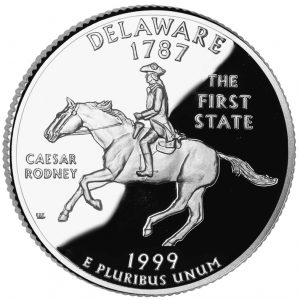 It never ceases to amaze me that even the most seasoned and esteemed numismatists do not understand how United States coinage goes from manufacturing to circulation.
It never ceases to amaze me that even the most seasoned and esteemed numismatists do not understand how United States coinage goes from manufacturing to circulation.
Recently, Harvey Stack wrote a column that appeared as a Viewpoint in Numismatic News (November 18, 2018). In the column, he blamed the U.S. Mint for problems with the distribution of the 50 State Quarters program. In the article Stack wrote that “the distribution of the new designs did not get full nationwide distribution. The Mint sent to most banks nationwide whatever they had available, with some districts getting large quantities of the new issue and other districts getting relatively few, if any.”
The U.S. Mint does not distribute circulating coins to any United States bank except the Federal Reserve. At the end of every production line is a two-ton bag made of ballistic materials that collect every coin produced on the line. When the bag is full it is sealed and later transported to a processing center designated by the Federal Reserve.
The U.S. Mint is a manufacturer. When they complete making the product, it is packaged in bulk and the customer, the Federal Reserve, picks up the product. Once the product is delivered to the client, that product’s distribution is no longer in the U.S. Mint’s control.
During the time of the 50 States Quarters program, the U.S. Mint had an agreement with the Federal Reserve to distribute the new coins first in order to get them into circulation. When the new coins were transferred to the various Federal Reserve cash rooms in the 12 districts, the Federal Reserve did circulate the new coins first.
What gets left out of the discussion is the logistics of transferring the coins from the cash rooms to the banks. The Federal Reserve does not deliver. Like many government agencies, the Federal Reserve relies on contractors to carry out that job. The Federal Reserve “sells” the coins to the logistics companies that bag and roll the coins and eventually deliver the coins to in armored vehicles to the banks.
In order to save money, these logistics companies keep their own supply of coins. This supply comes from the Federal Reserve cash room operations or excess they are given by the banks. Sine the logistics companies were not part of the deal that the U.S. Mint made with the Federal Reserve, a bank that asked for a delivery of quarters may have received quarters from the logistic company’s stock rather than new issues from the Federal Reserve.
Logistics is the coordination of complex operations and it is the job of these logistics companies to fulfill the inventory needs of the bank in the most efficient manner possible. It was more efficient to supply the banks in less densely populated areas with coins from current stock than transporting large amounts of coins from one of the Federal Reserve cash room operations that may be hundreds of miles away.
The U.S. Mint may do many things that collectors might take exception to, but the distribution of circulating coins is not their responsibility.
Coin image courtesy of the U.S. Mint.
Jul 21, 2018 | cash, coins, commentary, currency, markets, technology
 With the discovery of every new technology, there are the inevitable predictions that it will make the old ways obsolete. Although the automobile reduced the reliance on horses, the basics of the internal combustion engine have not changed in over 100 years. Take away the electronics around the engine, the technology increasing the air intake, and cleaning up the exhaust, and you still have an engine block with pistons that go up and down in the classic suck-bang-blow rhythm that was used in the Model T.
With the discovery of every new technology, there are the inevitable predictions that it will make the old ways obsolete. Although the automobile reduced the reliance on horses, the basics of the internal combustion engine have not changed in over 100 years. Take away the electronics around the engine, the technology increasing the air intake, and cleaning up the exhaust, and you still have an engine block with pistons that go up and down in the classic suck-bang-blow rhythm that was used in the Model T.
The latest technology that is being touted as being the doom for physical money, which can also be the end of numismatics, is cryptocurrency.
There are two aspects of cryptocurrency that its fans say are its biggest strength. First, it is not bound by the traditional means of generating wealth. You can think of cryptocurrency as digital gold. It is mined using computers and a lot of complex arithmetic to generate one unit of the currency, sometimes referred to as a bitcoin. Like physical gold, there is some work required to mine for these bitcoins. It lies in the ability to create a computing environment capable of performing these intensive mathematical operations. You may not be panning for gold but you might spend as much on equipment and travel.
The other aspect about cryptocurrency is that the blockchain technology allows for both anonymous and secure transactions. Think of the blockchain as a giant ledger that is copied wherever bitcoin is accepted with regular updates. There is no single source that could control the ledger nor is there a single point of failure.
However, both its strengths are its greatest weaknesses.
While the value of money is regulated by their respective government there are no blockchain regulations. There is no regulation on the number of generated bitcoins but is arbitrarily set by the creator of the cryptocurrency. There is no guarantee of value as a state-sponsored currency. Bitcoin investors are betting on the value of electronics and math, something many of these investors does not fully understand.
The blockchain also provides its own problems. In order to use the cryptocurrency, you have to have your own copy of the ledger and be able to pass the information to the party you want to pay. Think about having a checkbook with everyone’s information. You cannot read the information because it is encrypted but you have to have a copy. Then you need to pay someone. You hand over the checkbook in order to complete the transaction.
Think about the amount of data that would be if the blockchain supported 1,000 people. What would it take to support 1 million people? What if the government decided that everyone would do their business in bitcoin and everyone would have to have a way to deal with the blockchain in order to facilitate payments. How cumbersome will that ledger be if all 325.7 million people in the United States had to carry that around?
Each blockchain is its own entity. While you can trade in bitcoins on the same blockchain, you may have to participate in more than one blockchain if you want to accept bitcoins from several different people. It is like different currencies today. I can go anywhere in the United States and use dollars. But if I wanted to go to Canada, I can either arrange an exchange or find someone who will trade.
Cryptocurrency that has to operate across different blockchains is just like going to Europe and having to change your dollars for euros.
As with anything that is computer-based and managed, there is always the security issues. Blockchains have been hacked. Although most of the hacks are based on compromised passwords, each hack yields millions of dollars in stolen cryptocurrency to the hackers and everyone who then does business with them on the same blockchain.
Eventually, this will lead to a cryptocurrency version of a Bank Note Reporter and Counterfeit Detector as was popular during the broken banknote period. Then it will be followed by a Cryptocurrency Act similar to the Currency Act that ended the broken banknote period proving George Santayana right as we repeat history.
Cryptocurrency is the darling of the technology industry and those in the financial industry that trade in high-risk investments. Even traditional financial services companies are spending a limited amount of risk capital on cryptocurrency investments. However, by all statistics, the number of consumers using cryptocurrency for transactions is less than 1-percent.
If Not Cryptocurrency The What About Credit Cards
Credit and debit cards remain the primary target that proponents of a cashless society use to promote their agenda. However, when faced with the realities of life in the United States, there are three statistics that work against their arguments:
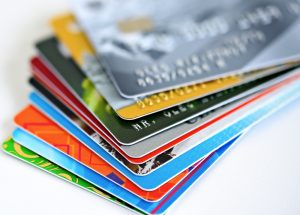
- The Bureau of Engraving and Printing, the printer of United States currency, reports a year-over-year increase in production of just over 4-percent.
- The U.S. Mint, the manufacturer of United States coinage, is reporting a year-over-year increase of 6-percent striking circulating coinage.
- According to CreditCards.com, “In 2013, 20 percent of whites did not have access to a credit card compared with 47 percent of African-Americans and 30 percent of Latinos.”
The primary customer for the Bureau of Engraving and Printing and U.S. Mint is the Federal Reserve. If the Federal Reserve needs the money for its operations, they buy it from these government bureaus. The Federal Reserve only orders what it needs. If it does not need the money, then it is not produced.
Aside from the over 50-percent of the population without access to credit cards, there continues to be a demand for physical currency. Whether the currency is used in a vending machine or to buy other items, cash is still king and shows no sign of slowing.
While there continues to be a demand for the products from the U.S. Mint and Bureau of Engraving and Printing, these bureaus will continue to produce coins and currency giving us more opportunity to collect their products.
 In last Sunday’s Weekly World Numismatic News, it opened with a discussion about how gold and silver were doing in the current market. While researching the data, the indication was that physical bullion and electronic purchases were driving the markets. Bullion coins were not a factor.
In last Sunday’s Weekly World Numismatic News, it opened with a discussion about how gold and silver were doing in the current market. While researching the data, the indication was that physical bullion and electronic purchases were driving the markets. Bullion coins were not a factor. As the stay or safe at home orders continue, news in the investing world around coins and bullion is whether there will be a recovery and what will happen.
As the stay or safe at home orders continue, news in the investing world around coins and bullion is whether there will be a recovery and what will happen. → Read more at
→ Read more at 
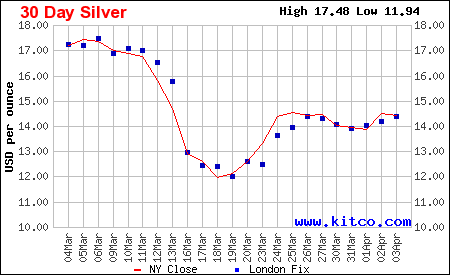








 With the discovery of every new technology, there are the inevitable predictions that it will make the old ways obsolete. Although the automobile reduced the reliance on horses, the basics of the internal combustion engine have not changed in over 100 years. Take away the electronics around the engine, the technology increasing the air intake, and cleaning up the exhaust, and you still have an engine block with pistons that go up and down in the classic suck-bang-blow rhythm that was used in the Model T.
With the discovery of every new technology, there are the inevitable predictions that it will make the old ways obsolete. Although the automobile reduced the reliance on horses, the basics of the internal combustion engine have not changed in over 100 years. Take away the electronics around the engine, the technology increasing the air intake, and cleaning up the exhaust, and you still have an engine block with pistons that go up and down in the classic suck-bang-blow rhythm that was used in the Model T.
